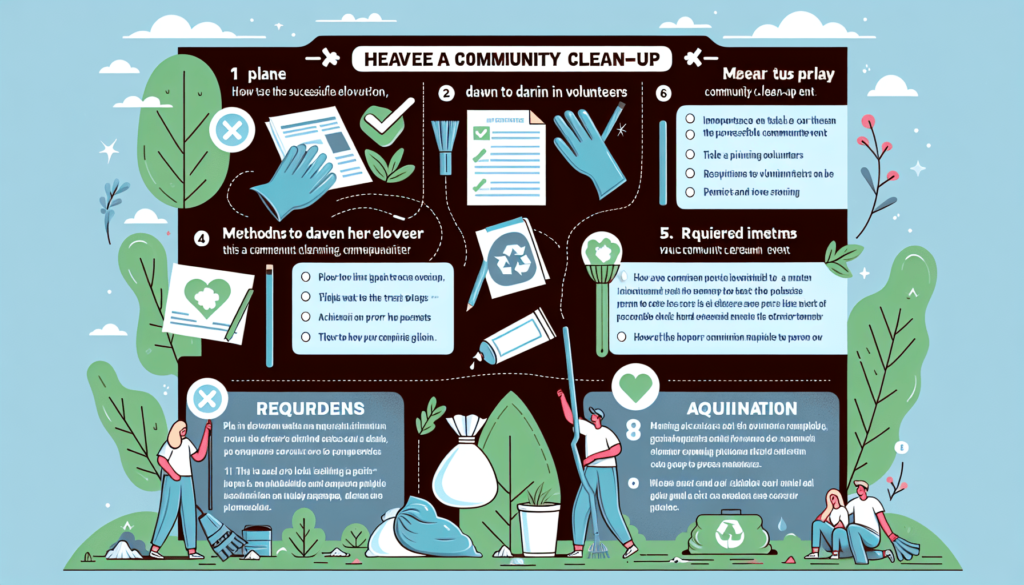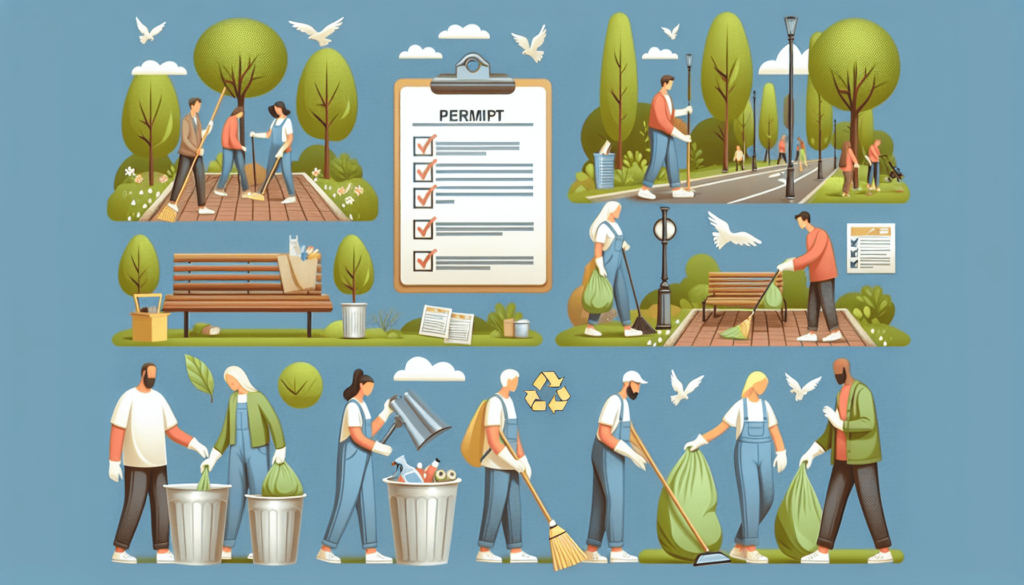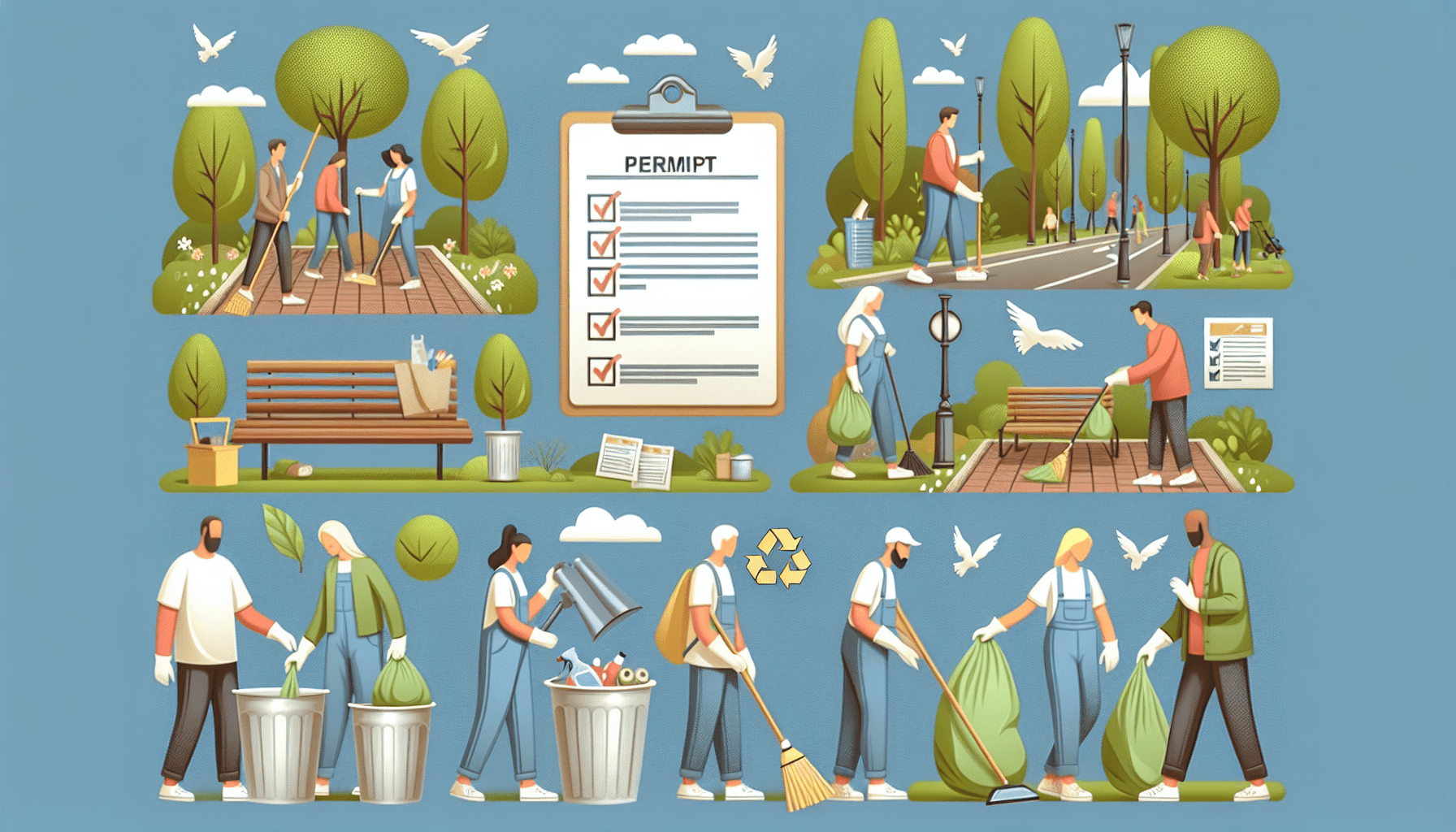If you’re looking to make a positive impact in your neighborhood and bring people together, organizing a community clean-up event is a fantastic initiative to consider. A community clean-up event not only helps beautify the surroundings but also fosters a sense of pride and unity among residents. In this article, we will explore some practical tips and steps to guide you in organizing a successful community clean-up event that will leave a lasting impression on both participants and the community as a whole. So, grab your gloves, roll up your sleeves, and let’s get started on creating a cleaner and happier neighborhood together!
Select a Date and Time
When organizing a community clean-up event, the first step is to select a suitable date and time. Consider the availability of the community members to ensure maximum participation. Choose a day and time that is convenient for the majority of the residents, such as a weekend when people are more likely to be available. This will help ensure a successful turnout and increase the impact of the clean-up effort.
Consider community availability
To determine the best date and time for the clean-up event, take into account the availability of the community members. Consider factors such as work schedules, school holidays, and other local events that may conflict with the chosen date. By selecting a time when people are more likely to be free, you can maximize the number of volunteers and create a sense of unity within the community.
Check for conflicting events
Before finalizing the date and time, it is crucial to check for any conflicting events in the community. Avoid scheduling the clean-up event on the same day as other significant local events, such as festivals or sporting activities. This will help prevent a decrease in participation and ensure that the clean-up event receives the attention it deserves.
Choose a suitable season or weather
Consider the season and weather when planning the clean-up event. Select a time of the year when the weather is pleasant and conducive to outdoor activities. Avoid extreme temperatures, heavy rain, or snowstorms that may deter volunteers from participating. By choosing a suitable season or weather, you can enhance the experience for participants and create a positive environment for community engagement.
Gather a Team
Organizing a successful community clean-up event requires a dedicated and motivated team. By gathering a team of volunteers, you can distribute responsibilities and tasks, making the event more efficient and manageable.
Recruit volunteers
Reach out to members of the community and local organizations to recruit volunteers for the clean-up event. Utilize social media platforms, community bulletin boards, and word of mouth to spread the word. Emphasize the importance of community involvement and the positive impact the event will have on the neighborhood. Encourage people of all ages and backgrounds to participate, as diversity will bring different perspectives and a greater sense of unity.
Assign roles and responsibilities
Once volunteers have been recruited, assign specific roles and responsibilities to each team member. This will ensure that all areas of the event are covered and that tasks are carried out effectively. Assign roles such as team leaders, registration coordinators, logistics managers, and safety officers. By distributing responsibilities, you can create a sense of ownership and build a stronger community bond.
Delegate tasks
Delegate tasks among the volunteers based on their skills and interests. Encourage individuals to take on tasks that align with their strengths, whether it’s organizing supplies, coordinating with local authorities, or promoting the event. By assigning tasks to passionate individuals, you can increase productivity and foster a sense of fulfillment among the team members.

Identify Areas for Clean-Up
Before the clean-up event, it is essential to identify the areas that require attention. Survey the community to determine where the clean-up efforts will have the most significant impact. By focusing on high-need areas, you can create a visible difference and inspire others to take pride in their community.
Survey the community
Engage with community members and local authorities to identify areas that require cleaning and improvement. Conduct surveys or hold community meetings to gather input and feedback on which areas need the most attention. This will help ensure that the clean-up efforts address the community’s specific needs and concerns.
Identify high-need areas
Based on the information gathered through community surveys, identify the high-need areas that will be the focus of the clean-up event. These areas may include parks, playgrounds, streets, or vacant lots that have become dumping grounds. By directing efforts towards high-need areas, you can make a visible impact and create a sense of pride within the community.
Consider safety and accessibility
When selecting areas for the clean-up, prioritize safety and accessibility. Ensure that the chosen locations do not pose any significant risks to volunteers, such as hazardous waste or unstable structures. Additionally, consider the accessibility of the areas for individuals with disabilities or limited mobility. By choosing safe and accessible locations, you can ensure the participation and involvement of a diverse group of volunteers.
Contact Local Authorities
To ensure a smooth and legal clean-up event, it is important to notify and coordinate with local authorities. This will help obtain necessary permissions and regulations while ensuring proper waste collection and disposal.
Notify local government
Contact the relevant departments within the local government to inform them about the clean-up event. This may include the parks and recreation department, public works department, or community services department. Provide them with details about the event, including the date, time, location, and estimated number of volunteers. By notifying the local government, you can establish a cooperative relationship and potentially receive support or resources for the clean-up event.
Obtain necessary permissions
Check with the local authorities to determine if any permits or permissions are required for the clean-up event. This may include permits for occupying public spaces or using equipment. Follow the necessary procedures to obtain these permissions in a timely manner, ensuring that all legal requirements are met. By obtaining the necessary permissions, you can conduct the clean-up event without any interruptions or legal issues.
Coordinate waste collection
Work with local waste management providers to coordinate waste collection during the clean-up event. Inform them about the estimated amount of waste that will be generated and any special requirements, such as hazardous or recyclable materials. Ensure that the waste collection services are scheduled to align with the event and that proper disposal methods are followed.

Create a Plan
To ensure the clean-up event runs smoothly, it is crucial to create a comprehensive plan. By establishing goals and objectives, developing a timeline, and allocating necessary resources, you can stay organized and focused on achieving the desired outcomes.
Establish goals and objectives
Clearly define the goals and objectives of the clean-up event. This may include objectives such as improving the overall cleanliness of the community, raising awareness about waste management, or fostering a sense of community pride and involvement. By setting specific and measurable goals, you can track the success of the event and communicate its impact to the community.
Develop a timeline
Create a detailed timeline that outlines all the necessary tasks leading up to the clean-up event. Include deadlines for obtaining permissions, recruiting volunteers, promoting the event, and procuring supplies. Break down the timeline into manageable steps, assigning responsible team members to ensure each task is completed on time. By following a timeline, you can ensure that the event is well-prepared and organized.
Allocate necessary resources
Determine the resources that will be required for the clean-up event and allocate them appropriately. This may include funds for supplies and equipment, volunteer recruitment efforts, marketing materials, and refreshments for the participants. Evaluate the available resources and seek additional support from local businesses, community organizations, or sponsors if necessary. By allocating resources effectively, you can ensure that the clean-up event is well-equipped and successful.
Promote the Event
To generate excitement and encourage community participation, it is crucial to promote the clean-up event effectively. By creating marketing materials, utilizing social media and local platforms, and engaging community organizations and influencers, you can spread the word and inspire others to join the cause.
Create marketing materials
Design eye-catching posters, flyers, and banners that promote the clean-up event. Include key information such as the date, time, location, and contact details. Highlight the positive impact that the event will have on the community and encourage people of all ages to participate. Distribute the marketing materials in local businesses, schools, community centers, and other high-traffic areas to reach a diverse audience.
Utilize social media and local platforms
Harness the power of social media to reach a broader audience and generate buzz for the clean-up event. Create event pages on popular platforms such as Facebook, Instagram, and Twitter. Share engaging content, including photos, videos, and testimonials, to showcase the importance of the event and its impact on the community. Additionally, consider utilizing local platforms such as community websites or newsletters to reach residents who may not be active on social media.
Engage community organizations and influencers
Collaborate with local community organizations and influential individuals to promote the clean-up event. Partner with local schools, churches, or youth groups to encourage their members to participate. Reach out to influential community leaders, such as city council members or prominent residents, and invite them to promote the event through their networks. By leveraging the support of community organizations and influencers, you can amplify the reach and impact of the clean-up event.
Organize Supplies and Equipment
To ensure a successful clean-up event, it is necessary to organize the supplies and equipment that will be needed. Determine the required tools and materials, arrange for their procurement or rental, and ensure that safety equipment is available for all volunteers.
Determine needed tools and materials
Assess the specific requirements of the clean-up event and determine the tools and materials that will be needed. This may include gloves, bags, brooms, rakes, shovels, or wheelbarrows. Take into account the type of waste that will be collected, such as general litter, recyclables, or hazardous materials, and select the appropriate tools accordingly. Consider the number of volunteers and the planned activities to estimate the quantity of supplies required.
Arrange for their procurement or rental
Once the required tools and materials have been identified, arrange for their procurement or rental. Check with local hardware stores, community centers, or waste management companies to determine if they offer discounted rates or donations for community clean-up events. Seek sponsorships from local businesses or apply for grants to cover the costs, if necessary. Place orders or make reservations well in advance to ensure availability on the day of the event.
Ensure safety equipment is available
Prioritize the safety of volunteers by ensuring that appropriate safety equipment is available. Provide gloves, safety vests, and first aid kits to all participants to minimize the risk of accidents or injuries. Encourage volunteers to wear comfortable and appropriate clothing for the clean-up activities. Assign safety officers to oversee the adherence to safety guidelines and provide assistance or instructions as needed.
Plan for Waste Disposal
Proper waste disposal is a crucial aspect of any clean-up event. Plan for waste collection and disposal in an efficient and environmentally responsible manner, considering recycling and proper sorting, and coordinating with local waste management providers.
Arrange for waste collection and disposal
Coordinate with local waste management providers to arrange for the collection and disposal of the waste generated during the clean-up event. Inform them about the estimated amount and type of waste to ensure that appropriate resources are allocated. Specify the collection points and discuss any specific requirements, such as separate containers for recyclables. Ensure that the waste collection services are scheduled to align with the clean-up event timeline.
Consider recycling and proper sorting
Promote sustainability by emphasizing the importance of recycling and proper waste sorting during the clean-up event. Provide separate bins for different types of waste, such as plastics, glass, paper, and organic materials. Educate volunteers about waste management practices and the importance of recycling. Consider partnering with local recycling centers or waste management facilities to provide education and resources for proper waste sorting.
Coordinate with local waste management providers
Maintain open communication with local waste management providers throughout the clean-up event. Notify them of any changes or additional requirements that may arise. Seek their guidance on any specific regulations or restrictions regarding waste disposal, hazardous materials, or bulk items. By coordinating effectively with local waste management providers, you can ensure that the clean-up event aligns with the municipality’s waste management policies.
Coordinate Day-of Logistics
On the day of the clean-up event, it is important to coordinate the logistics to ensure a smooth operation. Establish a registration/check-in system, assign teams to different areas, and provide refreshments and breaks to keep volunteers motivated and energized.
Create a registration/check-in system
Implement a registration or check-in system to keep track of the volunteers participating in the clean-up event. Assign team members to handle the registration process, welcoming volunteers, and distributing necessary materials such as gloves, bags, and safety equipment. Use digital systems, such as online registration forms or QR code check-ins, to streamline the process and reduce paperwork. This will help ensure that the event runs efficiently and that all volunteers are accounted for.
Assign teams to different areas
Divide the volunteers into teams and assign them to different areas within the community. This will help distribute the workload and ensure that all identified areas for clean-up are covered. Consider the size and skills of each team, as well as the specific requirements of each area. Assign team leaders to provide guidance and support to their respective teams, fostering a sense of camaraderie and teamwork.
Provide refreshments and breaks
Keep volunteers motivated and energized throughout the clean-up event by providing refreshments and breaks. Set up stations where volunteers can rest, hydrate, and grab a snack. Consider partnering with local businesses or sponsors to provide water, snacks, or light meals for the participants. Ensure that there are enough designated break areas to accommodate the number of volunteers and encourage socialization and community bonding during these breaks.
Lead the Clean-Up
As the organizer of the community clean-up event, take the lead on the day of the event. Ensure the safety of all participants by giving a safety briefing, supervise the activities, and encourage teamwork and community spirit.
Give a safety briefing
Before the clean-up activities commence, give a safety briefing to all participants. Highlight the importance of following safety guidelines, such as wearing protective gear, lifting heavy objects properly, and identifying and reporting any hazards. Emphasize the need for teamwork, communication, and looking out for one another throughout the event. Encourage volunteers to ask questions or seek assistance if they are unsure about any tasks or procedures.
Supervise activities
As the organizer, take on the role of supervising and overseeing the clean-up activities. Ensure that the assigned teams are working efficiently and effectively. Monitor the progress of each team and provide guidance or support as needed. Address any issues or concerns that may arise, such as waste sorting or safety violations. By actively supervising the activities, you can maintain the momentum and quality of the clean-up event.
Encourage teamwork and community spirit
Throughout the clean-up event, encourage teamwork and foster a sense of community spirit among the volunteers. Highlight the collective impact their efforts will have on the community and express gratitude for their involvement. Facilitate opportunities for volunteers to interact and collaborate, such as team challenges or community-building activities. By promoting teamwork and community spirit, you can create a memorable and fulfilling experience for all participants.
In conclusion, organizing a community clean-up event requires careful planning, coordination, and a dedicated team. By selecting a suitable date and time, gathering a team of volunteers, identifying areas for clean-up, contacting local authorities, creating a plan, promoting the event, organizing supplies and equipment, planning for waste disposal, coordinating day-of logistics, and taking a leadership role, you can successfully organize a community clean-up event that improves the cleanliness of the neighborhood and fosters a sense of unity and pride within the community.

